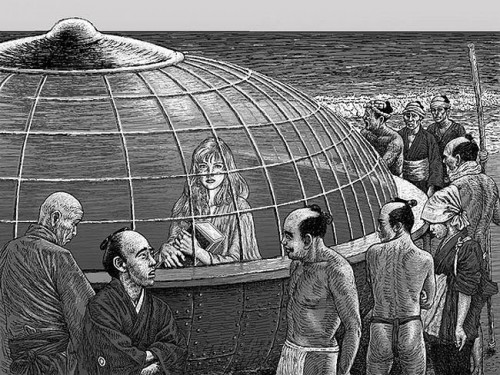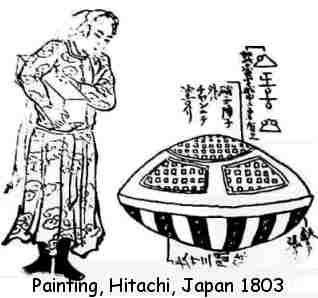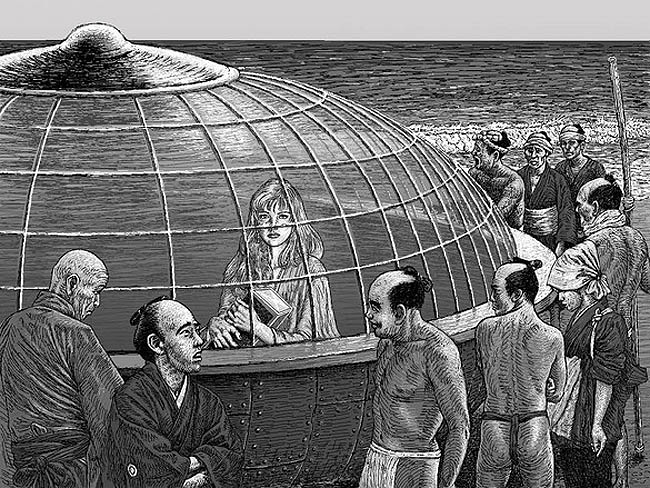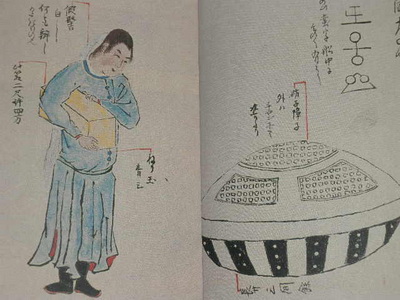The Edo period in Japan (1603-1867) was a prosperous time for the Japanese people. For most of this era, Japan was cutoff (almost) completely from the outside world. No trading, traveling, migrating or immigrating occurred during these couple hundred years. A total detachment from the young world; which was barely becoming aware of all its distant inhabitants, their customs, practices and religions. To the Japanese, this isolation allowed them to live war-free and instead focus on their culture, art and economic state.
During the Edo period, we begin to see Japanese folklore spread like wildfire throughout the island. Maybe the product of the isolation and boredom? Or maybe that’s just human nature. The stories kept making their way from the shores to the small inland villages. One of these stories in particular makes many Ufologists ask the question:
“Did Japan have an alien encounter of the third kind during the Edo Period?”
This is the story of Japan’s Utsuro-bune, or “hollowed ship”.
The year was 1803 and a few fishermen of the Harasha-ka-hama shore, which is located in the northern coast of Japan, were just about to relax from a hard day’s work when they spotted something strange coming towards the shore. From a distance, the men spotted what appeared to be a weird looking boat. The object seemed to have been aimlessly drifting through the Pacific Ocean. As it drifted closer and closer to the shore, the men decided to venture out into the waters and have a closer look at this “boat”. Cautiously, but more intrigued, the fishermen slowly glide towards the object as the tide helps bring it in. As soon as they were close enough, they noticed that this was no ordinary boat. At least nothing like they’ve ever seen before. The men quickly decide that they must inspect this strange vessel and tow it to shore. With a little guidance, they manage to drag the three by five meters wide vessel onto a safe spot on the beach. By now, more people were gathered around, curious to see what was inside this strange vessel. The men quickly surrounded it and began a close inspection of the construction materials. From what is known, the description of the upper part of this vessel resembled bamboo wood. It appeared to be very smooth and strong with a coat of red paint that covered the entire top part. Also on the top, were several glass or crystal windows that allowed them to peer into the vessel’s inside. These windows where covered by bars, maybe as ornaments, or maybe as a protective measure. As far as the lower part of the vessel, the legend reports it to be constructed out of brass plates. A truly bizarre design for that era. But what was more bizarre was what was on the inside of the vessel.
The inside of the vessel
Peering in, the fishermen saw that the inside was decorated by some foreign and strange looking text. The text, more like geometric symbols, confused the Japanese fishermen. What did they mean? Where did it come from?
Those questions would soon disappear as the men make a remarkable find. Inside the vessel, amongst the strange hieroglyphs there sat a young woman. According to the story, the woman was fairly young and appeared to be only eighteen or twenty years of age. She was described as having fiery-red hair and eyebrows and very smooth and very pale pink skin color. The men noticed that the woman inside the vessel had long white hair extensions and dressed in clothes that were made of unknown fabrics.
As the men quickly gather around the vessel and stare at this stranger, they note that she is clutching onto an elongated box. Holding it tightly against her chest. The woman stood up and the men jumped back. There, in plain daylight, the mysterious traveler emerged from the vessel and set foot in Japan’s northern shore.
The visitor
The men crowed around the mysterious visitor and they immediately noted that not only did she not look like them, she spoke in some unknown language. She was described as being very friendly and courteous. Both the fishermen and visitor tried to communicate with one another, but found it to be a futile effort. Sensing that they were not getting anywhere, the fishermen decided to find out why the woman held onto the elongated box so closely, as if guarding the contents of the box with her life. She never allowed anyone to touch the box and was described as acting suspicious when asked about it.
 This lead the men to later theorize that maybe what she carried in the box was the head of her lover. Which would explain her odd reaction to them wanting to look at its contents. But this was just a theory. The men tried again to communicate with the visitor, and she too tried to exchange information.
This lead the men to later theorize that maybe what she carried in the box was the head of her lover. Which would explain her odd reaction to them wanting to look at its contents. But this was just a theory. The men tried again to communicate with the visitor, and she too tried to exchange information.
After trying to communicate, the fishermen reported that the women, apparently had given up, and climbed back onto the Utsuro-bune and retreat back into the cold waters that brought her to their world.
Possible Explanations
Of course, trying to find an explanation for old folklore is an impossible task. On one end, history is filled with so many inconsistencies and fables that it becomes difficult at times to distinguish imagination from reality. On the other hand, why is it that we, as modern citizens of the world, feel the need to find scientific explanations for these tales?
Narcissism? Curiosity?
As I read through several online texts that talked about the legend, a few details of the story sounded a bit familiar. During the Viking age, the practice of burial at sea was something sacred to them. The Nordic people would often send the dead into the sea, via a small, but beautifully decorated boat. Inside with the dead was usually an array of things like relics, weapons food (fruits and horse meat) and sometimes they would throw in a sacrificed thrall. An unfortunate servant that is supposed to cater to her master in the afterlife. The thralls go through a ritual of eating, drinking and fornicating before being sacrificed by a stab to the chest, and setting her adrift in the boat.
Of course the Viking Age was hundreds of years before the Utsuro-bune incident, so it is highly dubious that this strange visitor that landed in Japan’s shore was from the Nordic territories. But we are just talking similarities here.
Another similarity to this story that popped in my head was the story of Auge. The ancient Greek who gave birth to the Greek hero Telephus. Auge’s father had been told by some oracle that his grandson would one day overthrow him and become ruler. Kind Aleus was to have non of that. Auge and her baby were put in a small crate like vessel and set adrift, into the endless sea.
his grandson would one day overthrow him and become ruler. Kind Aleus was to have non of that. Auge and her baby were put in a small crate like vessel and set adrift, into the endless sea.
But you see, these are all just similarities in the stories themselves. They origins of all three of these stories are separated by culture, race, vast distances in geography and the most important factor, time.
Could it be possible that the ancient Greek story made its way into the insular Japanese society? Was the story of the Utsuro-bune born out of broken translations?
In 1997, a Japanese professor became fascinated with the tale of the mysterious traveler and decided to launch his on investigation. Dr. Kazuo Tanaka from Gifu University in Tokyo concluded that the story was only a myth. He concluded that it was a combination of folklore and wild imaginations. Hardly a conclusion at all.
So then, what do we make of this story? Could it have been an encounter with a floating UFO (or USO)? Could the mysterious red haired women floated across the Pacific from America in some makeshift vessel? Or was she a visitor from another world? Possibly from outside our galaxy or a world that exists in the depths of the Pacific ocean.
One thing is for sure, the story of the Utsuro-bune will forever remain a mystery.
7 comments






